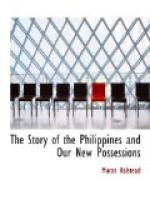that marked it with the blood of historic tragedy.
This poetry that it would have been high treason to
own in Manila, for it would not have been safe in
any drawer however secret, was treasured by the relatives
of the martyr at Hongkong. The niece spoke excellent
English, and there was at once surprise and gratification
in the family that an American should be interested
in the Doctor who sacrificed himself to the freedom
of his pen, so much as to ascend the steep places of
the city to seek his writings for the sake of the
people for whose redemption he died. On the page
showing the face of the Doctor and the scene of his
execution, there are two men in black, the victim standing
firm as a rock to be shot down, and the priest retiring
after holding the crucifix to the lips of the dying;
and the portrait of the beautiful woman to whom the
poet was married a few hours before he was killed.
It is said that Rizal wanted to go to Cuba, but Captain-General
Weyler answered a request from him that he might live
there, that he would be shot on sight if he set foot
on Cuban soil. Rizal, hunted hard, attempted
to escape in disguise on a Spanish troop ship carrying
discharged soldiers to Spain, but was detected while
on the Red Sea, returned to Manila and shot to death.
I stood on the curbstone that borders the Luneta along
the principal pleasure drive, between the whispering
trees and the murmuring surf of the bay, just where
the martyred poet and patriot waited and looked over
the waters his eyes beheld, the last moment before
the crash of the rifles that destroyed him, and in
the distance there was streaming in the sunshine the
flag of our country—the star spangled banner,
and long, long may it wave, over a land of the free
and home of the brave!
The picture of the cathedral shows a tower that was
shattered from the foundation to the cross by the
earthquake of 1863. Ambitious architecture must
conform to the conditions imposed by such disasters,
and the great edifice is greatly changed.
In our gallery we treat Admirals Sampson and Schley
as the President set the example. As there was
glory for all at Santiago, there was advancement for
both. We present them together. The wholesome,
manly face of General Lee is in the gallery. His
country knows him and thinks of him well.
The bombarded church of Cavite shows that shells spare
nothing sacred in their flights and concussions.
The Bridge of Spain is the one most crossed in passing
between the old walled city and the newer town that
was not walled, but was formidably intrenched where
rice swamps were close to the bay. The public
buildings are commodious and would be higher, but
the earth is uncertain, and sky-scrapers are forbidden
by common prudence. Our picture of the principal
gate of the walled city is taken truly, but does not
give the appearance of extreme antiquity, of the reality.
The wall looks old as one that has stood in Europe
a thousand years.




